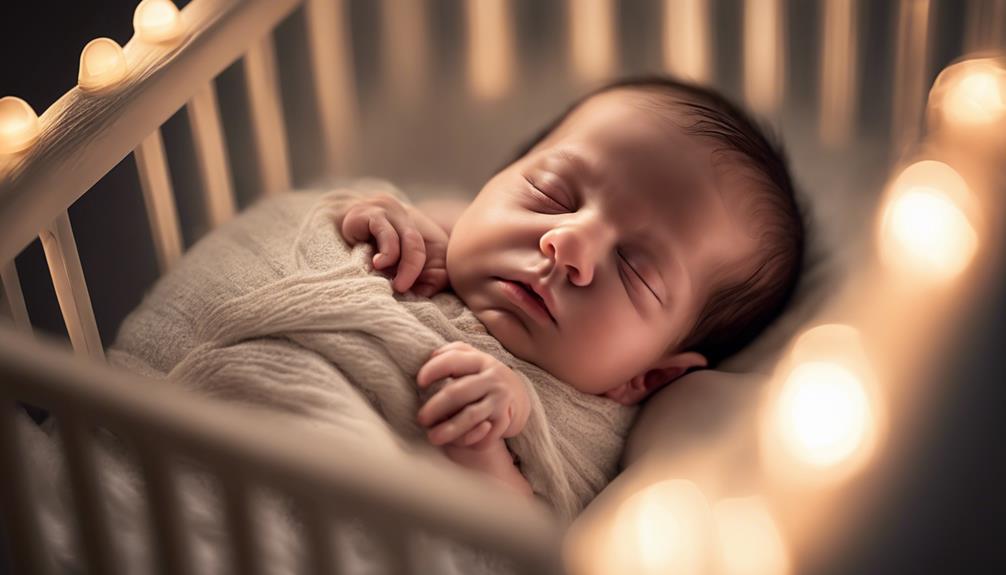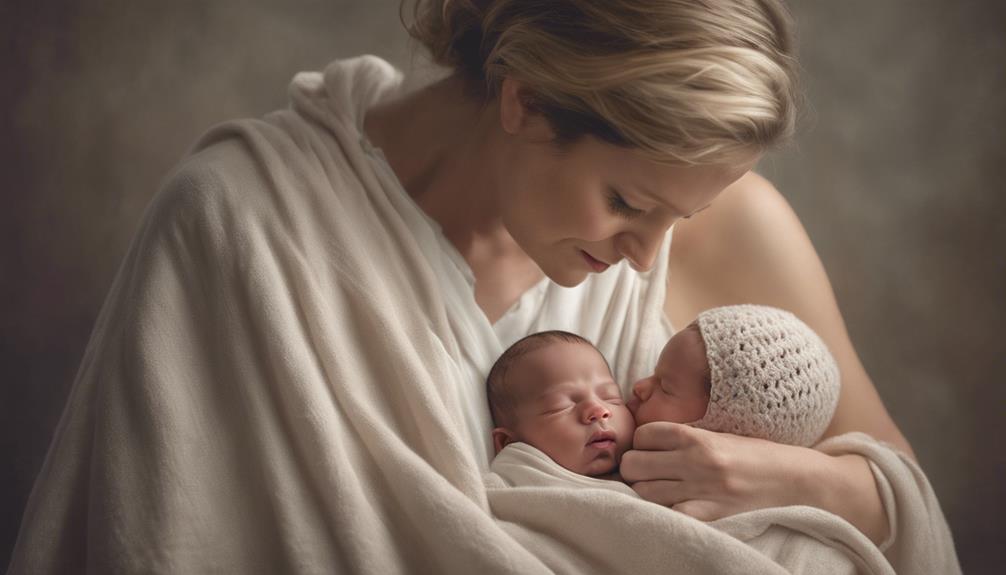As we navigate the complex world of newborn sleep, ensuring crib safety is like building a strong foundation for a peaceful night’s rest.
However, as we explore the nuances of creating a secure sleep environment for our little ones, a vital aspect often overlooked may surprise you.
Key Takeaways
- Place newborn on back on firm mattress to reduce SIDS risk.
- Avoid soft bedding, pillows, and toys in the crib.
- Regularly inspect crib for safety hazards like loose parts.
- Ensure spacing between crib slats is no more than 2 3/8 inches.
Safe Sleep Environment Recommendations
When creating a safe sleep environment for your newborn, it's important to follow these recommendations to reduce the risk of SIDS and maintain a secure sleeping space.
Placing the infant on their back on a firm crib mattress is important in minimizing the chances of SIDS, as recommended by experts. Using a tight-fitting bottom sheet specifically designed for cribs is essential to prevent entrapment hazards that could pose risks during sleep.
It's also advised to refrain from placing pillows, quilts, comforters, bumper pads, or stuffed toys in the crib to guarantee a clear and safe sleeping space for the baby. Positioning the baby with their feet towards the foot of the crib when using a blanket can further enhance safe sleep practices.
Additionally, checking that the spacing between crib slats is no more than 2 3/8 inches is crucial to prevent any potential entrapment issues. By adhering to these simple yet important recommendations, you can significantly reduce the risks associated with SIDS and create a secure sleeping environment for your precious little one.
Crib Safety Standards Overview

To assure the safety of your newborn while they sleep, understanding the crib safety standards established by the CPSC in 2011 is paramount. These guidelines set by the CPSC are stringent to guarantee infant safety.
Cribs manufactured after 2011 must comply with these CPSC standards for safety, emphasizing factors like smooth corner posts, securely attached hardware, and proper sizing. It's important to avoid cribs with drop-sides, cutouts in headboards or footboards, and any potential hazards that could pose a risk to your baby.
When selecting a crib for your newborn, remember to prioritize safety over aesthetics. While it's natural to want a visually appealing crib, ensuring it meets all safety standards is of utmost importance.
Setting Up the Crib Correctly

Setting up the crib correctly guarantees a safe sleeping environment for your newborn. To make sure crib safety and create a secure sleep space, there are key steps to follow when setting up your baby's crib. Here is a helpful guide to assist you in the crib setup process:
| Crib Safety Tips | Description |
|---|---|
| Firm Mattress | Use a firm mattress that fits snugly to reduce entrapment risks. |
| Secure Hardware | Check and tighten all hardware like screws and brackets to prevent hazards. |
| Safe Sleep Environment | Position the crib away from windows, cords, and curtains for a safe setting. |
| Regular Inspection | Regularly inspect the crib for wear, damage, or loose parts to address promptly. |
Common Crib Safety Mistakes

As parents, we must be aware of the common crib safety mistakes that can unknowingly put our newborns at risk. Keeping our little ones safe while they sleep is paramount, and avoiding these hazards is vital:
- Using Soft Bedding: Placing items like pillows, quilts, or stuffed toys in the crib may increase the risk of suffocation for infants. Opt for a firm mattress and fitted sheet instead.
- Bumper Pads: Despite their popularity, bumper pads can pose suffocation or strangulation hazards. It's best to keep the crib free of these items to ensure a safe sleep environment.
- Loose Bedding: Loose bedding not only increases suffocation risks but also poses entrapment hazards. Following safe sleep practices means keeping the crib bare and free of any potential obstructions.
Crib Safety Tips for Newborns

Investing in crib safety for newborns is crucial for creating a secure sleep environment. When putting your newborn down to rest, remember to always place them on their back to sleep to reduce the risk of Sudden Infant Death Syndrome (SIDS).
Opt for a firm, flat mattress in the crib without any soft bedding, pillows, or toys to promote a safe sleep space. Regularly inspect the crib for loose screws, missing hardware, or broken slats that could harm your newborn. Make sure the spacing between crib slats is no more than 2 3/8 inches to prevent entrapment.
It's essential to avoid using crib bumpers, blankets, or stuffed toys in the crib with your newborn, as these items can increase the risk of suffocation or entrapment. By following these crib safety tips, you can create a secure and comfortable environment for your newborn to sleep soundly.
Frequently Asked Questions
How Do I Make My Newborn Crib Safe?
To keep your newborn's crib safe, we guarantee a snug mattress, proper slat spacing, and secure hardware. Avoid cutouts in the headboard, footboard, or tall corner posts. Safety first for peaceful sleep!
Can a Newborn Safely Sleep in a Crib?
We absolutely can let newborns sleep safely in cribs! Following strict safety standards: firm mattress, tight sheet, no loose items. Back sleeping is a must, and regular crib checks are essential. Our little ones' safety is our top priority.
What Precautions Should Be Taken When Baby Is in Crib?
When baby is in the crib, we must place them on their back, confirm a firm mattress, and keep the crib bare. Precautions include avoiding pillows, quilts, bumper pads, or loose hardware to provide a safe sleep environment.
What Are the Safety Rules for Cribs?
We prioritize crib safety. Confirm slat spacing meets standards, corner posts are short, mattress fits snugly, all hardware is secure, and no cutouts are present. These measures prevent entrapment, suffocation, and strangulation risks.
Conclusion
In creating a safe sleep environment for our newborns, we lay the foundation for healthy sleep habits and peace of mind. Like a gentle lullaby, our attention to crib safety standards and practices creates a soothing rhythm for our little ones to rest peacefully.
Let's continue to prioritize their well-being by following these crib safety tips and ensuring a secure, comfortable sleeping space for our precious babies. Together, we can promote a safe and sound sleep for our newest family members.









